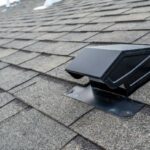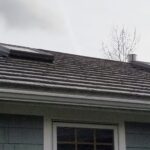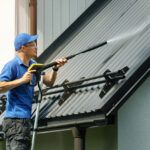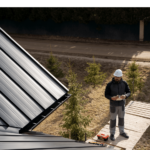Roof Insulation & Ventilation in Log and Timber Frame Homes
December 16, 2016 | By Mike Gonet | Filed under: Articles, Education, Metal Roofing, Technical
New England is a mecca for Log and Timber framed homes. It is also known for some of the craziest weather extremes and weather swings in the country. Roof insulation, as well as roof ventilation, is a topic that comes up in our daily conversations with our clients.
What is the correct way to insulate and ventilate a log or timber frame construction roof? By this question, we mean what amount of insulation should you have and should the roof be vented?
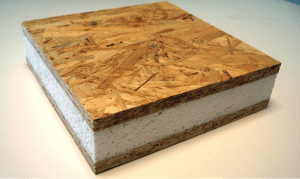
The “SIP” panel shown here has no air chamber and would be a Hot Roof system.
Building code requirements in MA have set the R value of roof or ceiling to unconditioned attic space at R 38. That is a great place to start. We have seen some projects go to R 45. An investment in insulation is well spent due to the rising energy costs. We all know that energy costs will not come down. If you are building a new home, there are several things to consider, including not only how much, but what type of insulation you are going to use. It is not the intent of this post to convince you of one type of insulation or another, nor are we suggesting a vented, cold roof system or a non- vented hot roof system.
Our intent is to make the reader aware of the options and the pros and cons of each.
One option that is widely available in new construction regarding insulation is the SIP panel roof. A “SIP” panel is a structural panel available in a multitude of dimensional sizes and thicknesses. They consist of some type of foam core insulation sandwiched between two structural boards. These types of insulation roof systems can cut construction cost, as they go in very quickly. They are also available with built in air space for ventilation or no ventilation in a hot roof configuration.
Then there is the option of using some sort of spray foam. This has become widely used today in new construction and is available in both closed and open celled foam.
First let’s consider closed cell foam insulation.
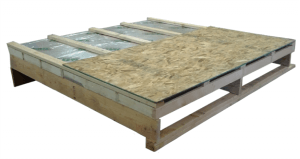
The picture above shows a “SIP” panel with a vent chamber. This would make the system a cold roof.
With closed cell foam insulation, the cells are closed and densely packed together and they are smaller in size. They are mixed with a gas which expands the foam. Because the cells are closed, this prevents air and water vapor from infiltrating, a well-engineered advantage that its open cell counterpart does not offer. It works very well as a roofing insulator and is also available in several densities.
The benefits:
Closed cell foam is very strong and ridged with significantly higher thermal resistance than most of the other options. It also prevents leakage of air and water vapor migration.
The disadvantages:
Because it’s more dense, it requires more material, which makes it more costly than the open cell option.
Closed cell foam has a higher R-value. The higher the R-value means more effective insulation; the rate per R value is higher than that of open cell foam.
What about open cell foam insulation?
Open cell foam is composed of tiny cells which are not enclosed. This type of foam is not as expensive. It works in blocking out air but is not an effective barrier against water vapor. Since the cells aren’t closed, air fills up the open space inside the material sometimes causing the foam to become weaker and easier to penetrate in comparison to the closed cell option.
The benefit:
Lower cost and an effective way to get a thorough insulation barrier in the roof.
Whether the choice is closed or open, spray foam insulation is a proven method to reduce energy expenses. Buildings in the U.S. with spray foam insulation are at least 50% more effective at preventing energy loss through air infiltration. Spray foam insulation also helps guard against the growth of mold and mildew and the decay of wood. In addition to controlling temperature and keeping moisture out, it also helps in soundproofing.
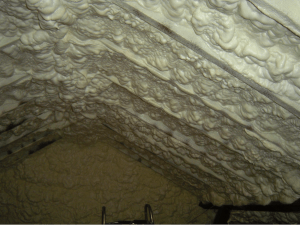
Shown above; both open and closed cell foam look about the same.
Recently, building scientists have been conducting tests and re-evaluating the accepted philosophy on roof ventilation. The Journal of Light Construction published an article, in which Ralph Britton with the Housing and Home Finance Agency is quoted,
“Un-vented roof assemblies performed well, showing no excess moisture accumulation, while the only vented roof assemblies that performed equally well had good vapor barriers and good workmanship.”
Here in New England, there are varying opinions on the subject. Our advice: do your homework.
The idea behind venting:
The reason to vent a roof in part depends on the climate you live in. In cold climates, like here in New England, the idea is to maintain a cold temperature under the roof deck. The reason is to help eliminate ice dam issues by keeping the roof cold. In hot climates or summer weather, the venting will keep the space below the roof cooler.
Venting a roof (cold roof) versus un-vented roofs (hot roof)- the differences:
Venting a roof not only helps with heat and cold regulation depending on the season, but it also removes moisture from the structure. This can all contribute to lower energy costs, as well.
The idea behind an un-vented roof:
A hot roof is designed to hold the heat in the building completely with high R values in the insulation and an air tight building envelope.
The tighter the building envelope the more effective the hot roof. Air leaks and poor air circulation can contribute to long term trouble that can lead to moisture build up, mold, and rot.
Mechanical air handling systems are the ideal situation when it comes to hot roof installation.
If you have an existing log or timber framed home, adding insulation and ventilation can be a major challenge and expense due to demolition costs. However, it can be done from the roof side at the time you replace your asphalt or cedar roof with a new aluminum metal roof. Many times, insulation and/or ventilation can be added to an existing roof making it function the way it is supposed to.
